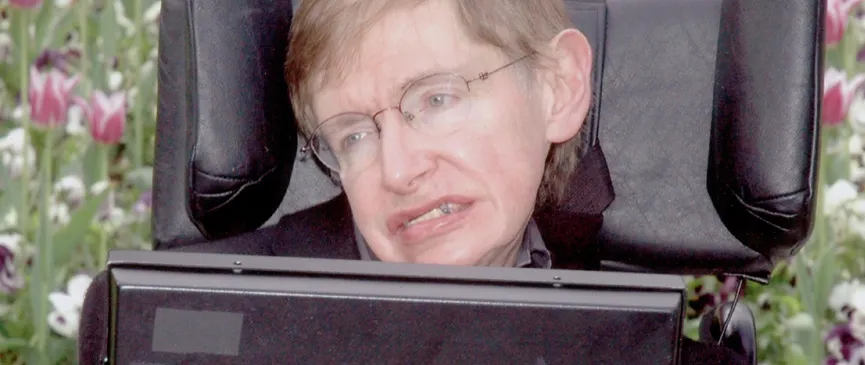Main content
Stephen Hawking Prince of Asturias Award for Concord 1989

Stephen Hawking (Oxford, UK, 1942 - Cambridge, UK, 2018) was the eldest of four children in a family of intellectuals. His father, a biologist specialising in tropical disease research, was a professor at University College, Oxford.
The immense curiosity that always accompanied him led him to become interested in the world of science, preferring Mathematics and Physics, as Natural Sciences seemed too imprecise to him.
His theories on the singularity of the Universe, the Big-Bang or explosion that originated the Cosmos and black holes revolutionized 20th-century physics, opening up new horizons for research. For many, Hawking was the response, in the second half of the century, to what Albert Einstein had achieved in the first half.
He was a mediocre student at secondary school, to the point that his father doubted that he could pass the entrance examination to the University of Oxford. However, he was admitted to the University in 1959 and, although he had a poor academic record, he obtained his degree, leaving the impression on his teachers of great intelligence, talent and a prodigious memory. A scholarship allowed him to carry out postgraduate studies at the neighbouring University of Cambridge, where he specialized in Theoretical Physics and Cosmology.
Hawking wanted to study with the famous astronomer Fred Hoyle, founder of the Institute of Astronomy, Cambridge, but was assigned Dennis Sciama. After leaving the Institute of Astronomy in 1973, he joined the Department of Applied Mathematics and Theoretical Physics, where he occupied the chair of Lucasian Professor of Mathematics from 1979 to 2009. This chair was established in 1663 with money left in the will of the Reverend Henry Lucas, who had been the Member of Parliament for the University. It was first held by Isaac Barrow, and subsequently in 1663 by Isaac Newton.
During his undergraduate years, Stephen Hawking made a trip to the Middle East where he contracted a virus which resulted in him suffering from amyotrophic lateral sclerosis, sometimes known as Lou Gehrig’s disease. This disease causes a gradual destruction of the central nervous system cells that regulate voluntary muscle activity, making the affected person lose motor control. However, the brain remains lucid. After doctors gave him less than two years to live, Hawking had a breakdown, leaving his job and suffering a serious depression. As time passed and he saw that the disease became stabilized, he rallied and, bound to a wheelchair, began his doctoral studies under the supervision of Professor Sciama. After obtaining his PhD, Hawking began working with the theoretical physicist Roger Penrose in the mathematical proof of the beginning of time. Around that time he was appointed Research Fellow of Applied Mathematics and Theoretical Physics at Cambridge, the department in which he later occupied a chair.
In 1974, he presented his theories on black holes at the Rutherford Laboratory. The scepticism of the specialists who had gathered there to hear him was overcome by the soundness of the young scientist’s arguments. That same year Hawking was elected a Fellow of The Royal Society (FRS) and, in 1978, received the Albert Einstein Award, considered the highest honour in Theoretical Physics. Professor Hawking was awarded twelve honorary university degrees. He was made Knight Commander of the British Empire (KBE) in 1982, becoming a Companion of Honour in 1989.
His scientific work has attempted to unify the Theory of Relativity with Quantum Mechanics, with the understanding that their “unification” might explain the origin of the Universe. His studies primarily focussed on black holes, regions of space where matter is so dense that gravitational effects are so strong that nothing escapes them. Hawking showed that the supposed “holes” are in fact thermal energy, a steady stream of particles with a power equivalent to that of six nuclear reactors. As to a general concept of the Universe, Hawking defines it as a space-time that is finite and curved, without borders or boundaries.
His numerous publications include The Large-Scale Structure of Space Time, with G.F.R. Ellis, General Relativity: an Einstein Centenary Survey, with W. Israel, and Three Hundred Years of Gravitation, also with W. Israel. Stephen Hawking has also published two books for the general public: his best seller, A Brief History of Time, and Black Holes and Baby Universes and Other Essays. His anthology, On the Shoulders of Giants. The Great Works of Physics and Astronomy, was published in 2003. He published A Brief History of Time in 2005.
End of main content
